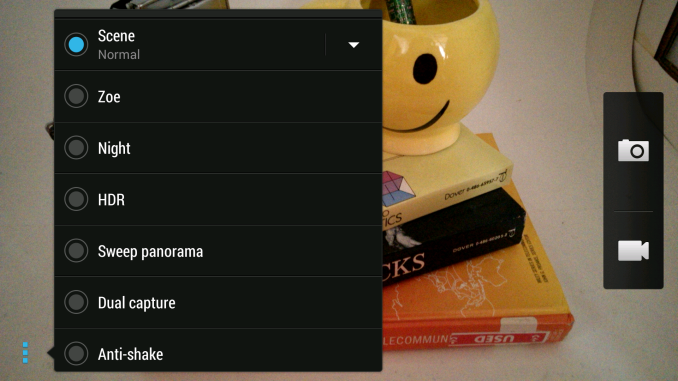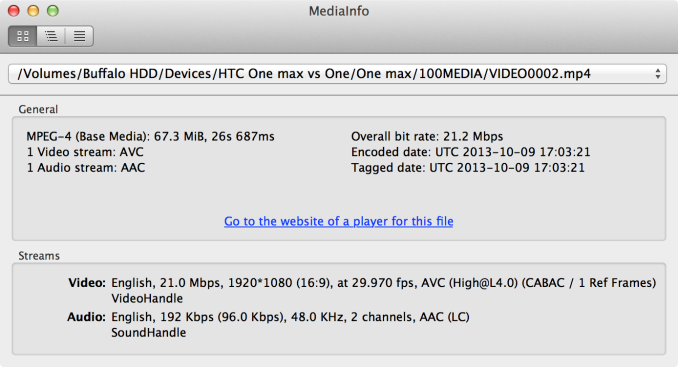HTC One max Review - It's Huge
by Brian Klug on October 28, 2013 10:00 AM EST- Posted in
- Smartphones
- HTC
- Mobile
- One
- Snapdragon 600
- Android 4.3
- One max
On the camera side we see HTC’s continued use of the 4 MP UltraPixel camera sensor on the back, with 2.0 micron pixels and 1/3" size. It’s the same CMOS sensor from ST (VD6869), and the same optics on top, with 3.8mm focal length and F/2.0 aperture. What’s different is that the One max doesn’t have OIS (Optical Image Stabilization), just like the One mini. That’s a bit unfortunate since OIS was one of the real highlights of the One, and we’ve seen another OEM follow suit with the inclusion of OIS to good success (LG’s G2) and will likely see Samsung do the same. On the front facing camera we have an Aptina AS0260 CMOS sensor with 2.1 MP resolution and 1.4µm pixels.
| HTC One Camera Specifications | |||||
| Device | HTC One | HTC One max/mini | |||
| Sensor Size and Type | 1/3" BSI CMOS | 1/3" BSI CMOS | |||
| Resolution | 4.0 MP 16:9 Aspect Ratio (2688 x 1520) | 4.0 MP 16:9 Aspect Ratio (2688 x 1520) | |||
| Focal Length | 3.82mm | 3.82 mm | |||
| F/# | F/2.0 | F/2.0 | |||
| Optical System | 5P | 5P | |||
| OIS | 2-axis +/- 1 degree, 2 kHz sampling | No OIS | |||
My thoughts about the HTC One camera system have definitely evolved over time, though I’m still glad HTC took a big risk and went this way, I’d like to see resolution traded off a bit less in the next generation. Good imaging often takes a balanced approach, I’d love to see larger pixels somewhere around 1.65 µm and as many as possible while still being pragmatic about sensor size. I hate to bring up the iPhone 5s as a comparison point, but something without as far of a tradeoff would be great. I’m still a fan of the HTC One camera indoors where other cameras struggle, but outdoors the resolution tradeoff is definitely there. Losing OIS means losing one of the things about the One system that made it special and standout in my mind. I could understand it being gone in the One mini for cost reasons, but the One max really should’ve had it considering its mission – everything about the One, taken to the max.
There’s a couple new features in the camera as a part of Sense 5.5 as well. Dual capture has been added to the camera as a shooting mode. We’ve seen this from other OEMs – it allows the front facing camera to be superimposed on the rear facing camera, or vice versus.
It’s a great feature for taking a selfie in front of something while traveling, which is ultimately its primary use case, I guess. There’s also an ‘anti shake’ mode which seems to be an EIS enhanced mode, but again this doesn’t preclude getting blurry pictures when the One max takes longer exposures, from what I’ve found.
Gallery: Smartphone Camera Bench
With the exception the performance tradeoff that comes from lacking OIS (higher chance of getting blurry photos from hand shake), imaging performance on the One max is really unchanged versus the One or One mini. I’m not going to go into super great detail here, but again I’d love to see the future One series a bit more resolution without trading off too much sensitivity.
Video
The One max has the same set of video modes as the other One, normal 1080p30, slow motion video, fast HD (720p60) and Video HDR (1080p30). In addition the shot in shot mode also works in video, so you can have yourself superimposed over video of whatever you’re shooting as well.
Video is recorded at a maximum of 1080p30 H.264 high profile with a 21 Mbps bitrate, and stereo audio. 1080p30 is great, but it’d be awesome to see 4K UHD video record which I was spoiled by on the Note 3, that’s another thing that’s a matter of SoC and CMOS needing a bit more.
I took videos on the One max at the standard bench location (MP4) and also compared to the One with OIS to illustrate the tradeoff in stabilized video that comes with its removal. I think it’s fairly easy to make the case that it should’ve been there. I also swear I wiped down the One max front facing glass to prevent glare, but the One max video shows some haze from light leakage. I’d love to see more OEMs move to coated sapphire cover glass on the camera, something I don’t believe HTC has.























































197 Comments
View All Comments
BlakKW - Monday, October 28, 2013 - link
+2cbrownx88 - Monday, October 28, 2013 - link
+3MarcSP - Monday, October 28, 2013 - link
+4hrrmph - Tuesday, October 29, 2013 - link
+5The Saint - Monday, October 28, 2013 - link
"I’ve said my part already on microSD cards and the fact that they’re going the way of the dodo in smartphones, I just don’t need one anymore, and definitely not at the expense of build quality. It is convenient not having to use a SIM ejector tool though, even if I carry one around all the time anyways. For the incredibly small percentage of users that clamors for an SD card every single smartphone launch, it’s at least one point which won’t be belabored so tiresomely this time."That's funny. Seems to me if there's one thing that seems to be going the way of the dodo, it's Android manufacturers like HTC who think prettiness and premium feel are more important than functionality. It will be nice once they go out of business to be able to stop hearing from that tiresome segment of pretend geeks who treat their cellphones like how divas treat their purses - as fashion accessories.
Meanwhile, Samsung will continue laughing by being both the only player that focuses on functionality, and the only player that makes money in the Android world.
nerd1 - Monday, October 28, 2013 - link
Apple charges $100 for 16GB memory and you can find 32GB micro SD at around $15. I wonder why most reviewers conveniently ignore this fact and just compare the baseline price of the products. I can do the math and I won't buy any device without expandability.Drumsticks - Monday, October 28, 2013 - link
I'm not sure that expandibility is the biggest selling point for galaxy phones outside of tech enthusiasts. Most people are not movie hogs etc and find 32GB reasonable. Business users and media enthusiasts on the other hand, would. But they don't represent everyone. Especially with streaming.I think its more brand name appeal and how much more recognizable they are. After all, apple does even better, and its not like they've ever offered MicroSD support.
personally I just think 16GB needs to die, and 32 should be standard up to 128GB in $50 increments max using high quality flash.
Spunjji - Monday, October 28, 2013 - link
Agreed about 16GB needing to die. But why would it when plenty of companies still make an extra $100 per sale by forcing people to upgrade to the minimum serviceable level? At least the Micro SD slot, with all its failings, allows some sort of other option. "pay as you grow" instead of throwing the whole shebang away when your storage needs outpace the crappy little chip soldered into your device.The0ne - Monday, October 28, 2013 - link
My decision on a phone is1. Screen size and resolution
2. MicroSD slot
I use my phone more as a e-reader and media device than a phone. That's not to say I don't use it as a phone normall, I do but it's not all that it does. Duh? Having the MicroSD slot for expansion is Godsend. All my books and technical PDF's are there. All my music, videos and photos are there (just the favorite ones), and so forth.
Why wouldn't you want to have all of those on your phone? It is convenience for me. One device to do what I like to use it for.
Davidjan - Tuesday, October 29, 2013 - link
Agree with you. We can use OTG reader to expand storage like Meenova MicroSD Reader if we want: http://goo.gl/U6IyY